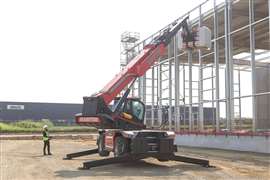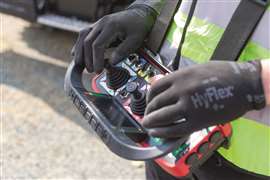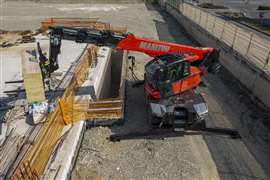Rotating telehandlers: A natural addition to your rental fleet

Partner Content produced by KHL Content Studio
30 April 2024
Rotating telescopic handlers offer unique benefits over their traditional, fixed-boom cousins. By remaining stationary on the jobsite, picking and placing from one spot, these multi-tasking machines are able to maximize space, increase construction efficiency and bring more bang for the buck to fleet owners.
 Manitou’s MRT 3060 has a maximum lift capacity of 6 tonnes. Photo: Manitou
Manitou’s MRT 3060 has a maximum lift capacity of 6 tonnes. Photo: Manitou
Properly equipped with the right attachments and a trained operator, a rotating telehandler can take the place of three different pieces of equipment – telehandler, mobile elevating work platform and light crane (under 7metric tons).
Steve Kiskunas, product manager for telehandlers at Manitou North America, answers questions about how rotating telehandlers can make an ideal addition to your rental fleet.
Q: How do rotating telehandlers differentiate your rental fleet from the competition?
Kiskunas: Rotating telehandlers can give you the advantage of offering something unique and relatively new in the marketplace, while justifying higher rental rates.
More than ever, rental is the preferred method of managing equipment placement needs. Even though the rental rate may be higher for the rotating machines vs. traditional telehandlers, contractors are able to write off that cost to the project without tying up their money on an asset they don’t need all the time.
National rental companies are very interested in this type of equipment because it provides them with a product that’s not the same as what every other rental company is offering. They’re able to charge a fair price for the rental and not worry about competition as much because it’s still relatively new in the market.
Rotating machines have a higher acquisition cost – an approximate 30% premium - and rental rates tend to follow suit.
Q: Do rotating telehandlers require more service and maintenance than fixed-boom models?
Kiskunas: Rotating machines operate differently from traditional telescopic handlers, and this can work to a rental company’s advantage.
For example, traditional telehandlers need to drive through poor soil conditions for a great deal of the time they’re being used. Rotating telehandlers, on the other hand, are most often stationary and rotating, so tires don’t wear out as quickly, and there’s less overall wear and tear on the chassis.
 Manitou says MRT telehandlers can be fully operated via remote control. Photo: Manitou
Manitou says MRT telehandlers can be fully operated via remote control. Photo: Manitou
Engine and hydraulic system service and maintenance is comparable between the two machine types, but rotators experience less overall wear and tear on the chassis.
Q: How does operation compare with traditional telehandlers? Is there a steep learning curve for renters operating rotating telehandlers?
Kiskunas: That’s a great question. When asked why there isn’t a higher volume of these machines being adopted in the North American rental industry, one of the hesitations is the concern about this very question: If I have a rotating telehandler in my fleet, is it going to be difficult for me to explain how to use this machine? The answer is no.
It’s a very straightforward familiarization process as far as operation. The machine itself guides the operator, giving them information about the weight of the load, where they’re positioned, and what their capacity is.
We’ve worked very hard to make sure the operating experience is the very best for the operator. In our new products, we have a 9” by 12” tablet that displays all the pertinent information. It’s a very large visual indicator of the status of the machine, and it provides a lot of information to assist the operator in becoming familiar with how the machine works.
Q: Attachments are key to telehandlers’ utility. Can attachments cross over between traditional and rotating models?
Kiskunas: The physical connection is the same, however, with the rotating machines there is what we call an attachment recognition system. There’s an RFID tag on the attachment so that when you connect that attachment to the rotating Manitou machine, it tells you what your load chart is based on your machine position - whether you’re on tires, facing forward or facing to the side, whether your outriggers are fully or partially extended, and so on.
It will give you the correct capacity for the machine in that position with that attachment. And because of that need to have the recognition of which attachment has been connected to the machine, it’s only those attachments with this special system that we allow to be used with the rotating machines.
We have a full selection of attachments for the rotators; all different sizes for carriages, jibs, booms, hooks, buckets, work platforms. Many of the standard attachments that you would use with a standard telescopic handler are also available for rotating telescopic handlers.
 Materials handling made easier with a Manitou MRT 2260 telehandler. Photo: Manitou
Materials handling made easier with a Manitou MRT 2260 telehandler. Photo: Manitou
Q: What’s unique about Manitou rotating telehandlers?
Kiskunas: We were the first manufacturer to offer a rotating product in North America. We’ve been doing this since the 1990s, so we’ve had over 25 years of experience with rotating machines in North America.
We understand the difference between European and North American operators, and we’ve worked hard to make sure the rotating product that’s available in North America meets the needs of North American customers. That separates us from our competitors, particularly those who’ve only just come into the market over the past couple of years.
We’re paying close attention to the operating experience, improving visibility for the operator when picking up materials, as well as throughout the lifting range so they’re able to easily see where they’re placing materials.
We’re really working hard on operator comfort because operators typically spend their entire day in the cab of the rotating machine.
We have two tiers of rotating telescopic handlers - the Vision Series and the Vision Plus series. The Vision Series is more of an entry-level product with a somewhat more limited rotation capability than the Vision Plus units. Also now the Electric series with two models.
The entry-level product is very good for those looking for just one of the three reasons to buy the rotator. For example, perhaps they’re looking for lifting height, or they’re looking for reach, but they don’t necessarily need fast production. If they want to have all three benefits, then they’ll want to go with Vision Plus because that machine will give them the capacity, the reach, and the efficiency.
Manitou has a long history with telehandlers, having launched its first drive-and-place model in 1981, followed by the rotating MRT 1540 in 1993. The West Bend, WI based manufacturer now offers 11 rotators in its MRT Series, the largest with a maximum lift height of 113 feet and a max capacity of 15,400 pounds.
This article was produced by KHL Content Studio in partnership with Manitou and Manitou product experts.
STAY CONNECTED



Receive the information you need when you need it through our world-leading magazines, newsletters and daily briefings.
CONNECT WITH THE TEAM






